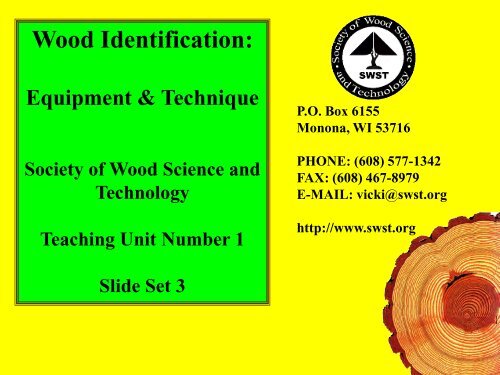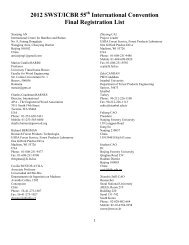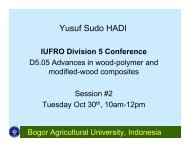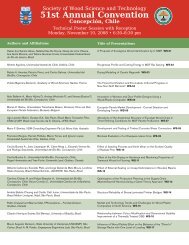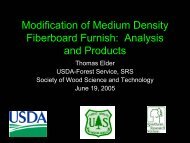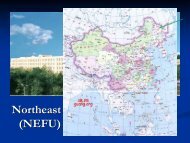Wood Identification - Society of Wood Science and Technology
Wood Identification - Society of Wood Science and Technology
Wood Identification - Society of Wood Science and Technology
You also want an ePaper? Increase the reach of your titles
YUMPU automatically turns print PDFs into web optimized ePapers that Google loves.
<strong>Wood</strong> <strong>Identification</strong>:<br />
Equipment & Technique<br />
<strong>Society</strong> <strong>of</strong> <strong>Wood</strong> <strong>Science</strong> <strong>and</strong><br />
<strong>Technology</strong><br />
Teaching Unit Number 1<br />
P.O. Box 6155<br />
Monona, WI 53716<br />
PHONE: (608) 577-1342<br />
FAX: (608) 467-8979<br />
E-MAIL: vicki@swst.org<br />
http://www.swst.org<br />
Slide Set 3
Background<br />
This part <strong>of</strong> SWST’s teaching unit is intended only to introduce<br />
the subject <strong>of</strong> wood identification <strong>and</strong> does not represent a<br />
comprehensive tutorial. It will, however, help you get started<br />
with wood id.<br />
The presentation focuses on six wood samples for the purpose<br />
<strong>of</strong> studying wood structure <strong>and</strong> to introduce h<strong>and</strong>-lens<br />
identification. A h<strong>and</strong> lens is necessary for observation <strong>of</strong> wood<br />
cell structural characteristics. You will also need to have<br />
several (10 or 15) single-edge razor blades for use in producing<br />
smooth cross-sectional (end-grain) cuts on which many<br />
diagnostic anatomical features may be observed.<br />
If you haven’t already, you should contact SWST to purchase<br />
the wood block set <strong>and</strong> a h<strong>and</strong> lens prior to attempting the rest<br />
<strong>of</strong> this unit.<br />
SWST Teaching Unit 1 Slide Set 3
Study <strong>of</strong> the slides <strong>and</strong> the text accompanying<br />
Teaching Unit 1, Set 2 - Structure <strong>of</strong> <strong>Wood</strong><br />
provides basic terminology for wood anatomy<br />
<strong>and</strong> should be completed prior to attempting<br />
wood id. Take a minute or two now to review.<br />
Pay particular attention to slides 31-33 <strong>and</strong><br />
34-37 which are low-magnification views <strong>of</strong><br />
wood that reveal the degree <strong>of</strong> structural<br />
detail discernable at 10 to 16X magnification.<br />
Comparison <strong>of</strong> the wood samples with these<br />
images is helpful as you learn to tell woods<br />
apart based on cross-sectional anatomy.<br />
SWST Teaching Unit 1 Slide Set 3
The wood blocks included in Unit No. 1 Slide Set<br />
3 are each labeled with a number corresponding<br />
to the following:<br />
1 = red oak (Quercus spp.)<br />
2 = white ash (Fraxinus spp.)<br />
3 = yellow-poplar (Liriodendron tulipifera)<br />
4 = southern yellow pine (Pinus spp.)<br />
5 = spruce (Picea spp.)<br />
6 = redwood (Sequoia sempervirons)<br />
SWST Teaching Unit 1 Slide Set 3
<strong>Wood</strong> <strong>Identification</strong>:<br />
Equipment <strong>and</strong> Technique<br />
Identifying wood using the cell features is a bit <strong>of</strong> a challenge at<br />
first because we are not used to looking at fine cell structure <strong>and</strong><br />
attributing it to particular wood types. But, with a little<br />
practice, a good h<strong>and</strong> lens, <strong>and</strong> a smooth, clean surface, it<br />
becomes quite routine. As you will see, it is a systematic process<br />
<strong>and</strong> not a mysterious art.<br />
<strong>Wood</strong> id. is based on examining the anatomical features <strong>of</strong> a<br />
wood specimen usually with a h<strong>and</strong>-held magnifying glass <strong>of</strong><br />
10X - 15X power (a h<strong>and</strong> lens). So knowledge <strong>of</strong> wood anatomy<br />
from Teaching Unit 1- Set 2 - Structure <strong>of</strong> <strong>Wood</strong> is crucial to<br />
your success in wood identification. Continually review Set 2 as<br />
you go through the rest <strong>of</strong> this unit.<br />
SWST Teaching Unit 1 Slide Set 3
Let’s get started<br />
In most cases, wood id. begins with examining the end grain<br />
surface <strong>of</strong> the specimen. End-grain is also known as the crosssectional<br />
surface <strong>of</strong> a wood block. This is the surface that is<br />
exposed when the wood cells have been cut perpendicular to<br />
their length (at a right angle to the tree stem axis). Growth rings<br />
are seen as arcs on this surface. <strong>Wood</strong> cells are seen as circles<br />
<strong>and</strong> holes, rather like looking at the ends <strong>of</strong> straws or tubes.<br />
Review slides 3, 4, <strong>and</strong> 14 in Unit 1 Set 2.<br />
Equipment: To identify wood using cell anatomy features, you<br />
will need to cut the end grain surface so cleanly that the<br />
essential cell features can be seen easily. The best tools are single<br />
edge razor blades <strong>and</strong> a 10X - 15X h<strong>and</strong> lens (magnifying lens).<br />
A bench clamp is especially useful for holding small samples<br />
while cutting.<br />
SWST Teaching Unit 1 Slide Set 3
Before we cut any wood, FIRST a word or two <strong>of</strong><br />
CAUTION:<br />
Specimen preparation involves using extremely sharp tools <strong>and</strong> is<br />
therefore an inherently dangerous activity. Proper technique will<br />
minimize your risk. The next section describes how to prepare<br />
specimens for identification using the cell features.<br />
Spend a little time getting acquainted with the technique<br />
first.<br />
SWST Teaching Unit 1 Slide Set 3
Specimen preparation<br />
The first step in specimen preparation is to identify the end grain surface or<br />
cross-sectional surface. It is shown below as the surface with the “X”.<br />
X<br />
X indicates the cross section<br />
R = Radial surface<br />
T = Tangential surface<br />
arrow indicates grain direction<br />
T<br />
R<br />
SWST Teaching Unit 1 Slide Set 3
<strong>Wood</strong> cuts best if the surface is slight wet, so the next step is<br />
to slightly moisten the surface to be cut (only the surface to be<br />
cut, <strong>and</strong> only slightly).<br />
Always use a fresh, sharp razor blade so that you do not have<br />
to exert excessive force to push (or pull) the blade through the<br />
wood. While the blade may look sharp, microscopic nicks <strong>and</strong><br />
rounding <strong>of</strong> the edge make the blade not sharp enough. Make<br />
only a few cuts per blade. BUT DO NOT CUT YET!!!<br />
Be sure to dispose <strong>of</strong> used razor blades properly in a rigid,<br />
sealable container. Do not throw them in the trash.<br />
SWST Teaching Unit 1 Slide Set 3
Next, secure the block tightly in a vise or grip the block firmly in<br />
your h<strong>and</strong> so that the cross section is up. See the picture below.<br />
If holding the block by h<strong>and</strong>, BE SURE to keep all your fingers<br />
BELOW the cutting surface <strong>and</strong> anticipate the direction <strong>of</strong> travel <strong>of</strong><br />
the blade. See the result <strong>of</strong> incorrect gripping in the next slide<br />
SWST Teaching Unit 1 Slide Set 3<br />
<strong>Wood</strong> block secured in vise
How to cut wood<br />
How to cut fingers<br />
SWST Teaching Unit 1 Slide Set 3
Now you are ready to make<br />
your first cut<br />
Now that you know how to grip the block, position the blade at the far<br />
corner <strong>of</strong> the block <strong>and</strong> pull the blade toward you in a FLAT slicing<br />
motion, taking a thin, light clean cut.<br />
Do not angle the blade too much, a flat cut is the way to go.<br />
Look at the example above for proper technique. Excessive force should<br />
not be required, if it is, the blade is TOO DULL.<br />
The goal is to provide a flat, clean surface that exposes at least 1 growth<br />
ring. NOTE: a large area is not needed, make only a small slice.<br />
Next up, how to look with your new h<strong>and</strong> lens.......<br />
SWST Teaching Unit 1 Slide Set 3
To view the cut surface, bring the h<strong>and</strong> lens up to your eye, THEN bring<br />
the block near the lens <strong>and</strong> move the block toward you <strong>and</strong> away until the<br />
wood surface is in focus.<br />
You can take the block out <strong>of</strong> the vise first if you prefer, entirely up to you.<br />
If you have a strong light that can be directed on the cut surface, that might<br />
help too. Look at the picture below for an example or how to use the lens.<br />
How to use your lens<br />
SWST Teaching Unit 1 Slide Set 3
Finally, what kind <strong>of</strong> wood is it?<br />
The first question that must be answered is whether the specimen is a<br />
s<strong>of</strong>twood or hardwood? (Unit 1 Set 2 slides 12-14). This can be<br />
accomplished by scanning the end grain surface for the presence or<br />
absence <strong>of</strong> vessel elements (see Unit 1 Set 2 slides 17, 21, 23, & 25, for<br />
examples <strong>of</strong> vessels).<br />
If the specimen has no vessels, the search for the wood type is immediately<br />
narrowed down to a s<strong>of</strong>twood c<strong>and</strong>idate. If the specimen has vessels which<br />
are obvious on the end grain surface, the specimen is one <strong>of</strong> the hardwoods<br />
<strong>and</strong> the next question that is usually asked is “what is the arrangement <strong>of</strong><br />
those vessel elements?” Refer to Unit 1 Set 2 for vessel arrangements,<br />
slides 21 - 26.<br />
If the specimen is a s<strong>of</strong>twood, an early question which must be answered is<br />
whether or not it is a resinous or non-resinous s<strong>of</strong>twood (see slides 16, 19,<br />
& 34-37).<br />
SWST Teaching Unit 1 Slide Set 3
Here are some id. features to look for in the wood blocks that are included<br />
in this unit:<br />
Oak <strong>and</strong> ash are both ring-porous hardwoods, with different latewood<br />
vessel patterns <strong>and</strong> differing ray widths. Oak has some VERY wide rays<br />
<strong>and</strong> some narrow rays, ash does not.<br />
Yellow-poplar is a diffuse porous hardwood. Vessels are almost the same<br />
size throughout the growth rings.<br />
Pine <strong>and</strong> spruce are s<strong>of</strong>twoods with resin canals, but the canals differ in<br />
their size (diameter). Pine has large, numerous resin canals, while spruce<br />
has small, sparse resin canals.<br />
Redwood is a s<strong>of</strong>twood with no resin canals. It has very large cells<br />
(tracheids) for a s<strong>of</strong>twood <strong>and</strong> lives up to its name – it’s red (or least dark<br />
brown).<br />
LOOK at the next few slides to see examples <strong>of</strong> the above types <strong>of</strong> wood.<br />
Then look for the features described above <strong>and</strong> in Unit 1 Set 2 on the end<br />
grain <strong>of</strong> your wood blocks.<br />
SWST Teaching Unit 1 Slide Set 3
Oak <strong>and</strong> ash are both ring-porous hardwoods,<br />
with different latewood vessel patterns <strong>and</strong> differing ray widths.<br />
Oak has some VERY wide rays, ash does not.<br />
latewood<br />
earlywood<br />
vessels<br />
red oak<br />
wide ray<br />
rays<br />
white ash<br />
cross section, 20X<br />
cross section, 20X<br />
SWST Teaching Unit 1 Slide Set 3
Yellow-poplar is a diffuse porous hardwood.<br />
Notice how the vessels are almost the same size throughout the growth ring.<br />
one growth ring<br />
vessels<br />
yellow-poplar<br />
cross section, 20X<br />
SWST Teaching Unit 1 Slide Set 3
Pine <strong>and</strong> spruce are s<strong>of</strong>twoods with resin canals,<br />
but the canals differ in their size (diameter).<br />
Pine has large, numerous resin canals, while spruce has small, sparse resin canals.<br />
resin canals<br />
southern yellow pine<br />
spruce<br />
cross section, 20X<br />
SWST Teaching Unit 1 Slide Set 3<br />
cross section, 20X
Redwood is a s<strong>of</strong>twood with no resin canals.<br />
It has very large cells (tracheids) for a s<strong>of</strong>twood <strong>and</strong><br />
lives up to its name – it’s red (or least dark brown).<br />
redwood<br />
cross section, 20X<br />
SWST Teaching Unit 1 Slide Set 3
Final thoughts:<br />
You are also encouraged to develop your own sets <strong>of</strong><br />
observations <strong>of</strong> the characteristics <strong>of</strong> the woods. Don’t forget<br />
that physical characteristics such as weight per unit volume<br />
(density), relative hardness, color, odor, <strong>and</strong> even taste may be<br />
important clues useful in wood identification.<br />
We hope you have fun as you step through this process <strong>and</strong><br />
observe wood’s unique cell features.<br />
Good Luck in your wood id endeavors. It just takes practice.<br />
SWST Teaching Unit 1 Slide Set 3
A number <strong>of</strong> books are available on the topic <strong>of</strong> wood identification. A couple <strong>of</strong><br />
recommend references are:<br />
Core, H.A., W.A. Cote, <strong>and</strong> A.C. Day. 1979. <strong>Wood</strong> Structure <strong>and</strong> <strong>Identification</strong>, 2nd<br />
ed. Syracuse University Press, Syracuse, New York. Note: This book is out <strong>of</strong> print<br />
but occasionally available at used book stores <strong>and</strong> via the internet.<br />
Flynn, J.H. <strong>and</strong> C.D. Holder (Eds.) 2001. A Guide to Useful <strong>Wood</strong>s <strong>of</strong> the World.<br />
Forest Products <strong>Society</strong>, Madison, WI. http://www.forestprod.org/<br />
Hoadley, R. B. 1990. Identifying <strong>Wood</strong>: Accurate Results with Simple Tools. Taunton<br />
Press, Newtown, CT.<br />
Milius, S. 2002. The <strong>Wood</strong> Detective. <strong>Science</strong> News. Vol. 162 No. 12 pages 184-185<br />
www.sciencenews.org<br />
Panshin, A.J. <strong>and</strong> C. deZeeuw. 1980. Textbook <strong>of</strong> <strong>Wood</strong> <strong>Technology</strong>, 4th ed. McGraw<br />
Hill Book Company, New York.<br />
Also try the USDA Forest Products Lab, Center for <strong>Wood</strong> Anatomy at:<br />
http://www2.fpl.fs.fed.us/Menu.ssi<br />
SWST Teaching Unit 1 Slide Set 3
Additional information concerning careers in the<br />
general field <strong>of</strong> wood science <strong>and</strong> technology, including<br />
those in production management, process engineering,<br />
technical sales, <strong>and</strong> product development can be<br />
obtained by contacting:<br />
<strong>Society</strong> <strong>of</strong> <strong>Wood</strong> <strong>Science</strong> <strong>and</strong> <strong>Technology</strong><br />
P.O. Box 6155<br />
Monona, WI 53716<br />
http://www.swst.org<br />
SWST Teaching Unit 1 Slide Set 3


